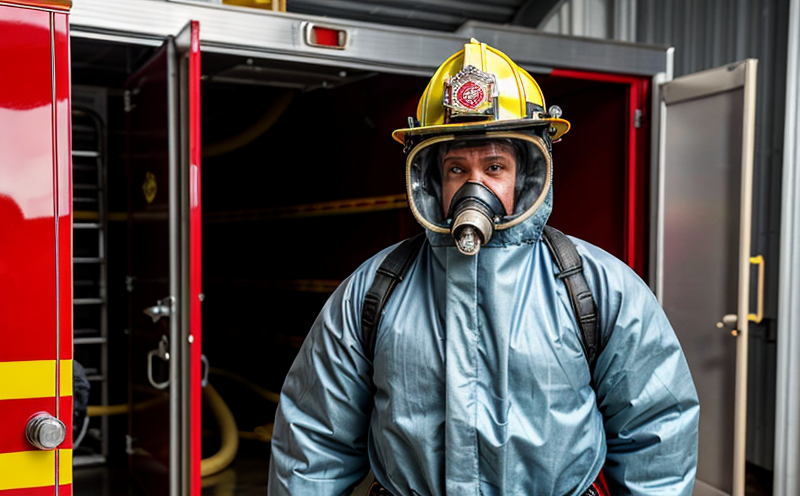Firfighter Gloves Puncture Resistance Testing
The testing of firefighter gloves for puncture resistance is a critical aspect of ensuring that protective equipment meets stringent safety standards. Firefighters must be able to perform their duties without compromising personal safety, and the ability of gloves to resist punctures under various stress conditions is essential for this.
Firefighters often encounter sharp objects, debris, and hazardous materials during rescue operations. Puncture resistance testing evaluates the glove's capacity to withstand penetration by sharp or pointed objects, which can lead to cuts that could compromise the integrity of the protective layer. This type of testing ensures that firefighters have gloves that are robust enough to protect them from potential injuries.
The test is conducted on a standardized specimen under controlled conditions that simulate real-world scenarios. The apparatus used for this test includes a puncture tester, which applies force in a specific manner designed to replicate the kind of impact a firefighter might encounter. Specimen preparation involves ensuring the gloves are consistent with industry standards and free from any defects.
Once prepared, the gloves undergo testing according to ISO 14120-3:2016, which is an international standard that specifies methods for determining the puncture resistance of protective gloves for hand protection. This method involves applying a force incrementally until penetration occurs and measuring the maximum load at this point.
The results provide critical information about the glove's ability to resist punctures, helping quality managers and R&D engineers make informed decisions regarding material selection and design improvements. The test also aids compliance officers in ensuring that products meet regulatory requirements set by various standards bodies worldwide.
For procurement personnel, this testing is vital as it ensures they are purchasing gloves that have been rigorously tested and proven to be safe for use in challenging environments. By choosing gloves that pass puncture resistance tests, organizations can enhance the overall safety of their workforce while also mitigating potential risks associated with non-compliant equipment.
Industry Applications
| Purpose | Type of Gloves | Industries |
|---|---|---|
| To ensure gloves are safe for use in environments with sharp objects. | Firefighter gloves, rescue gloves. | Firefighting, emergency services, industrial safety. |
| To evaluate the integrity of glove materials against punctures. | All types of protective gloves used by firefighters. | Broad range including forestry, construction, and hazardous waste management. |
The testing of firefighter gloves for puncture resistance is widely applicable across various industries. Firefighting is a primary application, but the results are also valuable in emergency services where quick response to dangerous situations may involve handling sharp objects or debris. In industrial settings, such as forestry and construction, workers may encounter similar hazards, making puncture resistance testing equally important.
For hazardous waste management facilities, gloves must be able to withstand various contaminants that could potentially cause cuts. This type of testing ensures that the protective gear used is up to standard for handling these specific challenges. By ensuring that gloves meet the necessary standards, industries can protect their employees and reduce the risk of accidents.
Why Choose This Test
Selecting the appropriate test method is crucial in maintaining the integrity and safety of firefighter protective equipment. Puncture resistance testing goes beyond simple visual inspections or basic durability checks; it provides quantitative data that can be used to improve product design and manufacturing processes.
The test helps manufacturers identify potential weaknesses in their gloves, allowing them to make adjustments before products reach marketplaces. This proactive approach ensures that only the highest quality equipment is available for use by firefighters. Additionally, compliance with international standards like ISO 14120-3:2016 not only guarantees that the gloves meet regulatory requirements but also enhances trust and confidence among end-users.
For procurement teams within organizations, choosing to test firefighter gloves for puncture resistance ensures they are selecting products that have been rigorously evaluated. This choice supports better decision-making when it comes to purchasing protective gear, ultimately contributing to a safer working environment.
The test also plays a vital role in reducing liability issues related to equipment failure. By ensuring that the gloves meet specified performance criteria, organizations can minimize risks associated with inadequate protection leading to injuries or fatalities during operations.
International Acceptance and Recognition
- ISO 14120-3:2016 is recognized globally as a standard for puncture resistance testing of protective gloves.
- American Society for Testing and Materials (ASTM) standards such as F1956 also provide guidance on glove performance.
- The European Committee for Standardization (CEN) has adopted EN 388:2018, which includes puncture resistance requirements among other factors affecting glove safety.
- International Organization for Standardization (ISO) standards are widely accepted in countries like the United States, Canada, and Australia.
The international acceptance of these standards ensures that firefighters have access to gloves meeting consistent quality benchmarks regardless of their location. Compliance with such standards provides peace of mind knowing that protective gear has been tested according to recognized protocols ensuring effectiveness and reliability.





